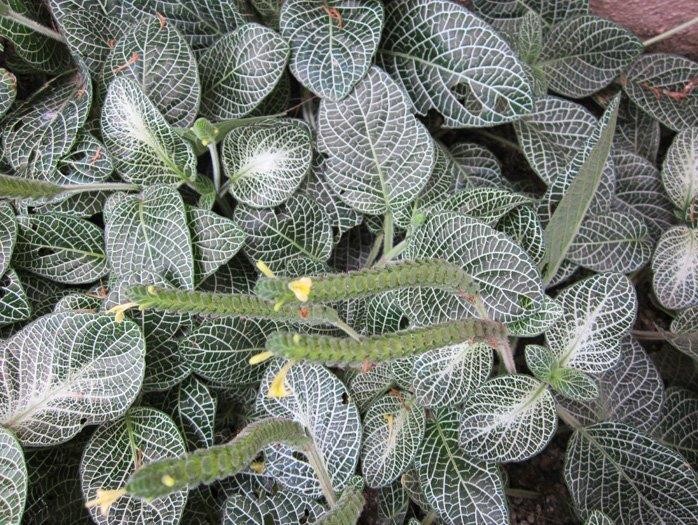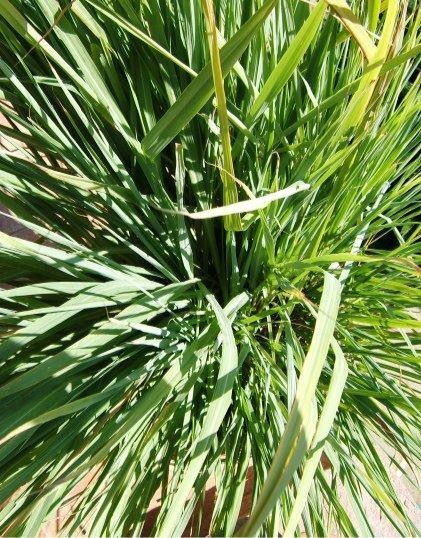By Tommy Clarkson from the June 2016 Edition
Family: Arecacea
Also known as: Miraguama Thatch Palm or Wiry Miraguama Palm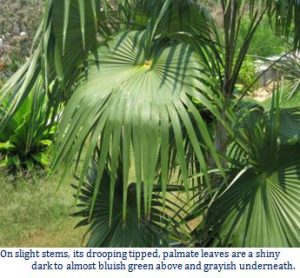
When I first saw this attractive, solitary-trunked species in a vivero about an hour from Ola Brisa Gardens it was labeled as a “Caribe Palm”. However, none of my books, reference materials, or internet sources called it that – only the one nursery where I found it! This was, however, a good tip as to its origin.
Depending upon which botanist to whom you turn, there are anywhere from 14 to 49 different species in this genus. But most agree that this is the most attractive of the lot!
In its native environs, it is unique to the savannas, hills, open woods and coastal areas of Cuba. (In fact, its name is that of a province in that small, island country.) There it has several localized, common names such as in Matanzas where it is called “Biraguano” and in Camaguey and the province of Las Villas where folks call it “Yuraguano” or “Yuraguana”.
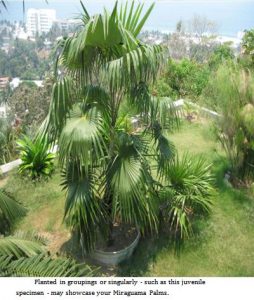 Research and experience has borne out that the Coccothrinax miraguama is somewhat popular among the more focused palm collectors but rather rare in private sector cultivation. In fact, other than in our gardens, the only other place I have seen it employed was poolside, in the lush tropical gardens of a Puerto Vallarta hotel.
Research and experience has borne out that the Coccothrinax miraguama is somewhat popular among the more focused palm collectors but rather rare in private sector cultivation. In fact, other than in our gardens, the only other place I have seen it employed was poolside, in the lush tropical gardens of a Puerto Vallarta hotel.
Now, firstly, this beautiful, slow growing, medium-sized palm has a thin trunk and a small crown of smallish, rigid, fan-shaped leaves.
(OK. Test time. Does the preceding information mean its fronds are pinnate of palmate? . . . . a pause while you remember . . .. Correct, I’m proud of you! You have been paying attention in the past. They are palmate!) The Miraguama Palm is one of the faster growers in the Arecacea family. When employed in one’s garden they are perhaps best displayed in groupings of varied sizes (as that pair I saw, of different heights, in PV and as we have likewise done with the two on the Grand Terrace in our gardens).
As mentioned earlier, of the numerous varieties in the Coccothrinax species, the miraguama probably has the best looking leaves. The starburst shaped fronds, 20 -30 per palm, form a complete – but partially divided – stiff circle of up to five feet 1.5 meters) in width and are comprised of 40-60 inverted V-shaped leaflets. These leaves are a shiny dark to almost bluish green above and grayish underneath.
The stems are slight only six inches in diameter but can be as long as four fee (1.2 meters) and are 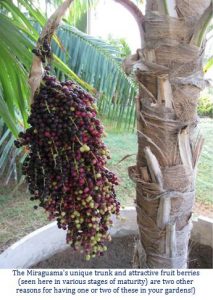 unarmed (without barbs/teeth). Its fruits range in color from red to a deep purple black.
unarmed (without barbs/teeth). Its fruits range in color from red to a deep purple black.
The trunk is perhaps its most unique aspect being covered with a fibrous sheath and if properly trimmed stubbed frond stems emanating upward and through this material. The degree of trunk matting may differ from palm to palm. He who I so greatly admire, Robert Lee Riffle, described these trunks as “An exceptionally beautiful woven mesh design of old leaf fibers and narrowly triangular leaf base covers younger parts of the stems, while older parts are bare and show closely set rings.”
The Miraguama Palm may grow to a height of between ten to fourteen meters (33-46’) with a crown spreading to just over 12’ (3.5 meters) or so, with a height of about 8’ (2.5 meters). That trunk, initially covered with old leaf bases and the fibrous sheath, is reminiscent of that of the Coconut or Date Palm but later cleans to a barky, smooth, gray colored trunk. It likes direct sun or light shade and needs well regular watering in well-draining, sandy soil. It is rather tolerant of the cold taking temperatures down to 26 to 28°F (-3 to -2°C).
From an up to three-foot-long (91 cm) inflorescences (flower stalk) protruding from the leaves, its white/cream/tan bi-sexual flowers come out in the late spring or early summer. From these come the fruit which are red and round when ripening, turning dark red and then to dark purple, almost black, when ripe. 0.5 inch in diameter.
As a result of the unique trunk, lithe leaf stems and large limpid fronds this unique palm is ideal as a “close up landscape subject” or for entryways, courtyards or patios. However, it’s not a good candidate as an inside featured plant.
If you’ve space and are able to find one, I encourage you to make it your own you’ll get no few positive comments on it!
Download the full edition or view it online
—
Tommy Clarkson is a bit of a renaissance man. He’s lived and worked in locales as disparate as the 1.2 square mile island of Kwajalein to war-torn Iraq, from aboard he and Patty’s boat berthed out of Sea Bright, NJ to Thailand, Germany, Hawaii and Viet Nam; He’s taught classes and courses on creative writing and mass communications from the elementary grades to graduate level; He’s spoken to a wide array of meetings, conferences and assemblages on topics as varied as Buddhism, strategic marketing and tropical plants; In the latter category he and Patty’s recently book, “The Civilized Jungle” – written for the lay gardener – has been heralded as “the best tropical plant book in the last ten years”; And, according to Trip Advisor, their spectacular tropical creation – Ola Brisa Gardens – is the “Number One Tour destination in Manzanillo”.



